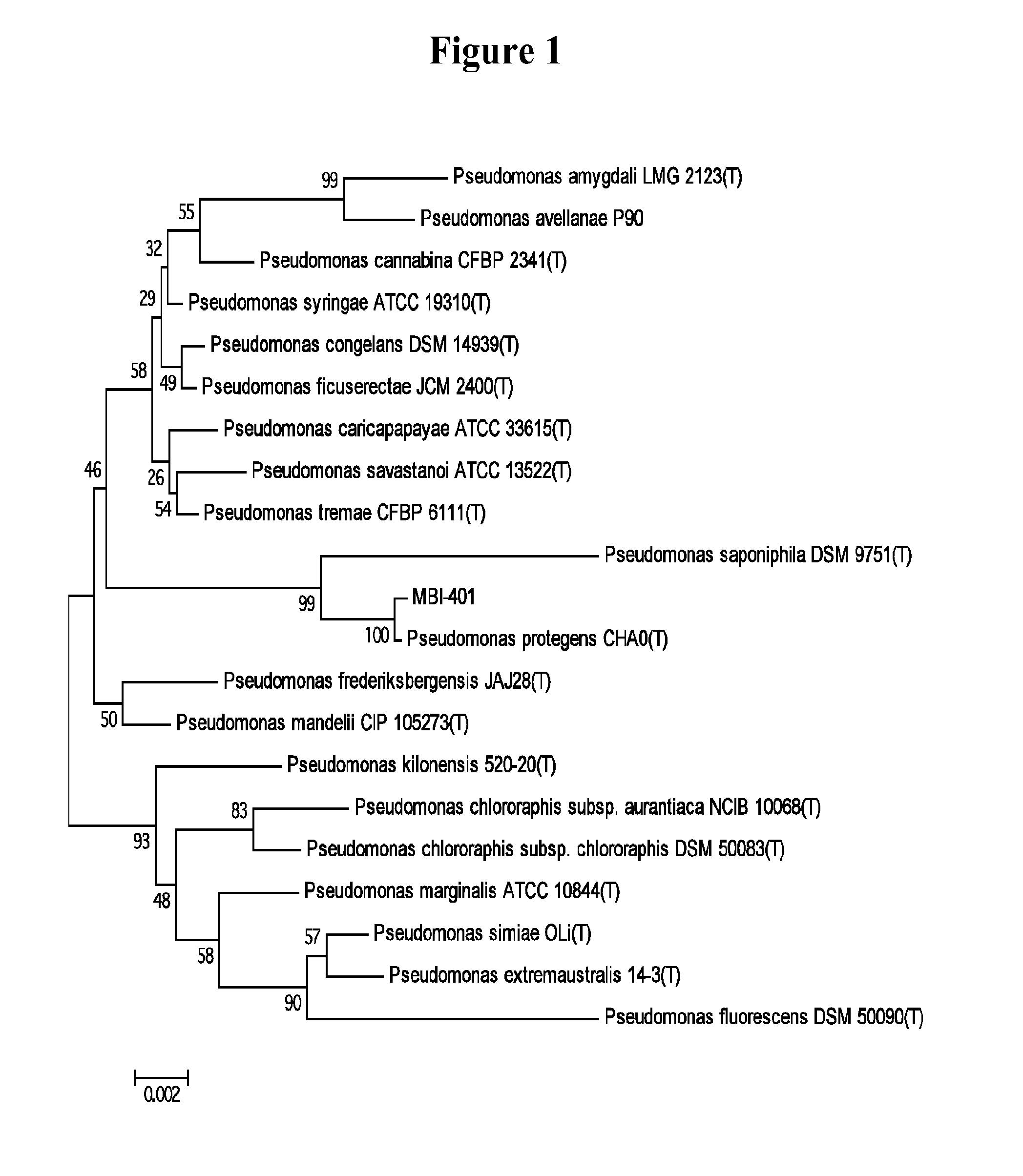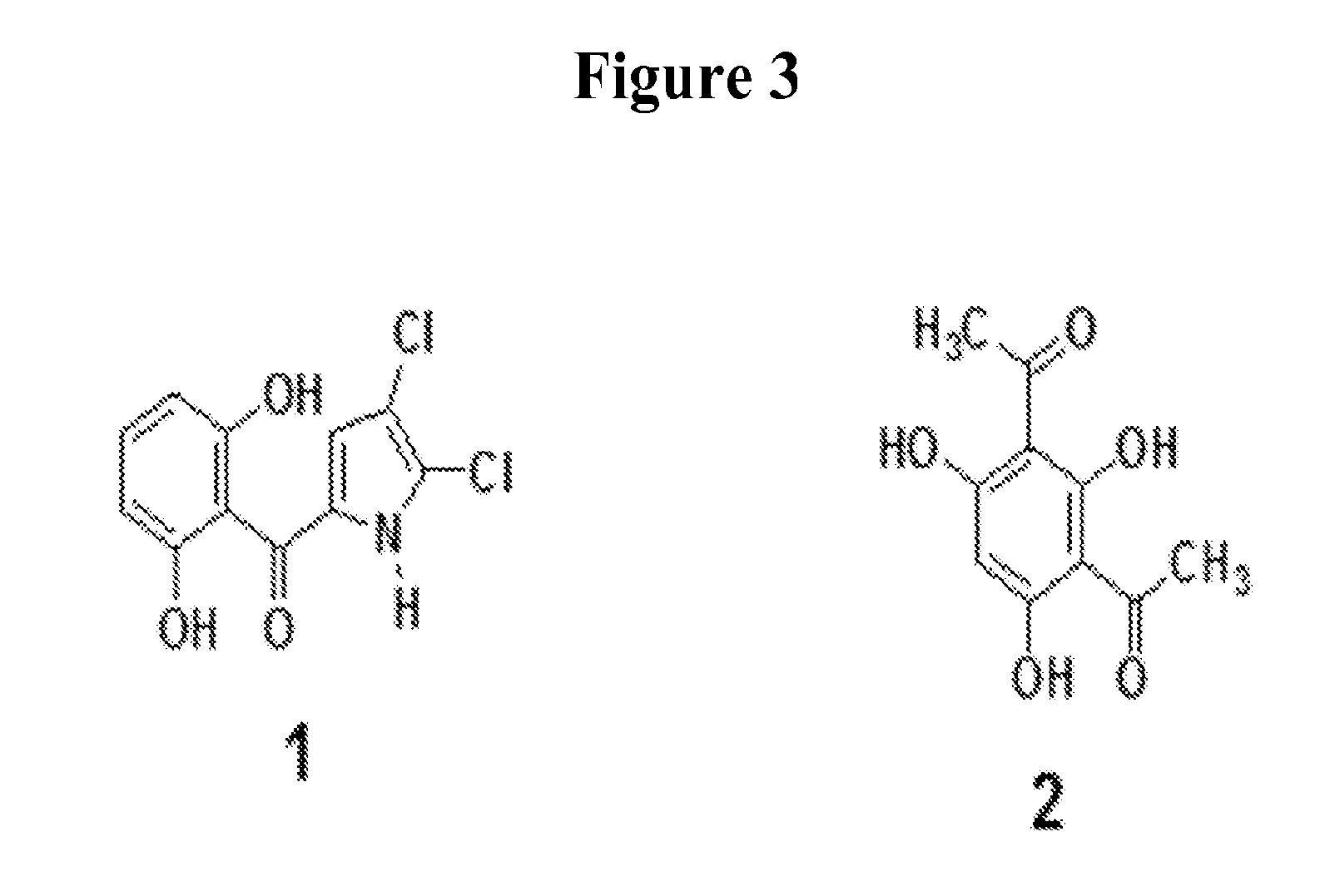Control of phytopathogenic microorganisms with pseudomonas sp. and substances and compositions derived therefrom
a technology of pseudomonas sp. and phytopathogenic microorganisms, which is applied in the field of phytopathogenic microorganism control, can solve the problems of no clear understanding of the mechanism of pathogen control, and the responsibility of agricultural production significant losses
- Summary
- Abstract
- Description
- Claims
- Application Information
AI Technical Summary
Benefits of technology
Problems solved by technology
Method used
Image
Examples
example 1
Analysis of Pseudomonas Strain CL145A (ATCC 55799)
[0107]The Pseudomonas strain CL145A (ATCC 55799) has been further characterized through a polyphasic approach by investigating its phenotypic and genotypic characteristics. The results from the studies disclosed herein indicate that CL145A is a better match to Pseudomonas protegens, rather than Pseudomonas fluorescens.
[0108]Recent developments in the taxonomical study of the genus Pseudomonas resulted in the creation of a new species Pseudomonas protegens, Pseudomonas protegens includes several strains formerly identified as Pseudomonas fluorescens including strains CHA0, PF, PGNL1, PGNR 1, PGNR 2, PGNR 3, PGNR 4, PINR 3 and Pf1. The basis of the reclassification is described by Ramette et al., (2011), and was officially validated in 2012 (Euzeby, 2012). Based on this new information, the best match for CL145A is Pseudomonas protegens. MBI-401 will now be identified as Pseudomonas protegens strain CL145A (CL145A).
[0109]CL145A was ch...
example 2
Preparation of Pseudomonas Fractions
[0137]The following procedure is used for the extraction of compounds from the cells and supernatant of Pseudomonas CL145A (ATCC 55799):
[0138]The cell pellet derived from the 10-L fermentation P. CL145A (ATCC 55799) in FM2 growth medium is suspended in dilution buffer and extracted with Amberlite XAD-7 resin (Asolkar et al., 2006) by shaking the cell suspension with resin at 225 rpm for two hours at room temperature. The resin and cell mass are collected by filtration through cheesecloth and washed with DI water to remove salts. The resin, cell mass, and cheesecloth are then soaked for 2 h in acetone after which the acetone is filtered and dried under vacuum using rotary evaporator to give the crude extract. The crude extract is then fractionated by using reversed-phase C18 vacuum liquid chromatography (H2O / CH3OH; gradient 90:20 to 0:100%) to give 6 fractions (see FIG. 4 for schematic).
2.1 Analysis of Active Fractions / Crude Extract
[0139]The compar...
example 3
Antimicrobial Testing: Growth Inhibition on Agar Plate
[0141]Pseudomonas strain CL145A was streaked on a PDA plate by spreading glycerol stock material as a single straight line across the diameter of the plate. The strain CL145A was allowed to grow for 24 hours at 25° C. After 24 hours incubation, the following isolates were inoculated in perpendicular line to the CL145A growth, coming as close as possible to the CL145A growth without touching it: Xanthomonas campestris, Xanthomonas vesicatoria, Pseudomonas putida, Bacillus cereus, Bacillus subtilis and Pseudomonas syringae. The plate was incubated for another 48 hours at 25° C. Inhibitory activity was determined by looking for lack of growth in proximity to the CL145A streak. Isolates inhibited did not grow toward the CL145 streak; X. campestris, X. vesicatoria and B. subtilis were significantly inhibited on the plate. Pseudomonas putida was not inhibited at all. Minimal inhibition of Bacillus cereus was observed. Pseudomonas syrin...
PUM
| Property | Measurement | Unit |
|---|---|---|
| Fraction | aaaaa | aaaaa |
| Fraction | aaaaa | aaaaa |
| Nanoscale particle size | aaaaa | aaaaa |
Abstract
Description
Claims
Application Information
 Login to View More
Login to View More - R&D
- Intellectual Property
- Life Sciences
- Materials
- Tech Scout
- Unparalleled Data Quality
- Higher Quality Content
- 60% Fewer Hallucinations
Browse by: Latest US Patents, China's latest patents, Technical Efficacy Thesaurus, Application Domain, Technology Topic, Popular Technical Reports.
© 2025 PatSnap. All rights reserved.Legal|Privacy policy|Modern Slavery Act Transparency Statement|Sitemap|About US| Contact US: help@patsnap.com



